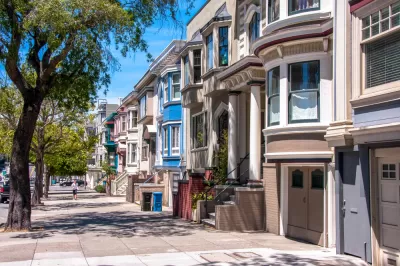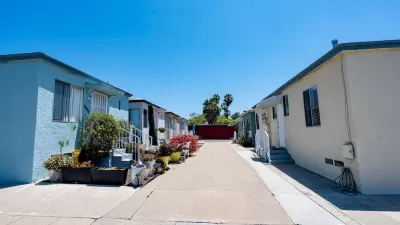As the housing crisis continues, advocates are increasingly wary of historic preservation efforts that serve to perpetuate historic inequities and keep housing costs high.

San Francisco’s St. Francis Wood neighborhood was just added to the National Register of Historic Places, making it much more difficult to build projects, reports Benjamin Schneider in the San Francisco Examiner. Housing advocates decry the move as a NIMBY action to prevent development in the area.
The historic designation makes the neighborhood exempt from SB9, SB10, and SB35, all state bills that allow for higher-density construction in an effort to alleviate the state’s housing crisis and undo decades of exclusionary and racist policies. “If you are preserving structures with the requirement that they remain single-family homes forever, when the origin of that single-family home was so Black people and Japanese people and Chinese people could not live there, is that really what you want to preserve?” asks Annie Fryman, a housing policy expert working for Abodu.
Activists worry that more communities will follow suit. “Already, wealthy communities from Palo Alto to Pasadena have tried to skirt SB 9, the statewide duplex law, by creating historic districts.”
“Fryman thinks there could have been a middle ground where the streets, parks and monuments of St. Francis Wood could have earned a historic designation but not the houses, which she describes as a ‘jumbling and sort of incoherent mix of 25 disparate revival styles.’”
While Fryman acknowledges that all neighborhoods can be precious to their residents, “If we historically preserve every neighborhood in San Francisco, we will be taking an enormous step backward, both in terms of equity and racial outcomes, and our housing crisis.”
Related Stories:
FULL STORY: St. Francis Wood earns historic designation, sparks backlash

Study: Maui’s Plan to Convert Vacation Rentals to Long-Term Housing Could Cause Nearly $1 Billion Economic Loss
The plan would reduce visitor accommodation by 25,% resulting in 1,900 jobs lost.

North Texas Transit Leaders Tout Benefits of TOD for Growing Region
At a summit focused on transit-oriented development, policymakers discussed how North Texas’ expanded light rail system can serve as a tool for economic growth.

Why Should We Subsidize Public Transportation?
Many public transit agencies face financial stress due to rising costs, declining fare revenue, and declining subsidies. Transit advocates must provide a strong business case for increasing public transit funding.

How to Make US Trains Faster
Changes to boarding platforms and a switch to electric trains could improve U.S. passenger rail service without the added cost of high-speed rail.

Columbia’s Revitalized ‘Loop’ Is a Hub for Local Entrepreneurs
A focus on small businesses is helping a commercial corridor in Columbia, Missouri thrive.

Invasive Insect Threatens Minnesota’s Ash Forests
The Emerald Ash Borer is a rapidly spreading invasive pest threatening Minnesota’s ash trees, and homeowners are encouraged to plant diverse replacement species, avoid moving ash firewood, and monitor for signs of infestation.
Urban Design for Planners 1: Software Tools
This six-course series explores essential urban design concepts using open source software and equips planners with the tools they need to participate fully in the urban design process.
Planning for Universal Design
Learn the tools for implementing Universal Design in planning regulations.
City of Santa Clarita
Ascent Environmental
Institute for Housing and Urban Development Studies (IHS)
City of Grandview
Harvard GSD Executive Education
Toledo-Lucas County Plan Commissions
Salt Lake City
NYU Wagner Graduate School of Public Service





























